Reflective Collage Portrait: Unraveling “Media as an Extension of Humans”

Summary
This Open Toolkit guides learners to explore the connection between "media as an extension of humans" and media ideology through reflective collage portrait creation, turning abstract media concepts into hands-on personal experiences.
The core impact of media does not come from the “content” it carries, but from the media itself as “an extension of humans.”
Specific Learning Objectives:
- By selecting, pasting, and annotating media materials, complete a collage portrait and use art works to reflect on media.
- Through reflection, understand the core concept of “media as an extension of humans” and recognise that everyday media carry implicit ideologies.
Understanding: Media Extension, and Ideology (5 minutes)
Step 1: Theory Introduction (3 minutes)
The core impact of media does not come from the “content” it carries, but from the media itself as “an extension of humans.”
People often misunderstand the significance of media to lie in how it is used, but McLuhan pointed out that the significance of media lies in reshaping human relationships and self-perception. This is not related to content.
Marshall McLuhan, “The Medium is the Message” in Understanding Media: The Extensions of Man (1964).
Explain the core with daily life examples:
– When you use Instagram to check outfits, Instagram “extends your aesthetic judgment.”
– When you use Google to look up travel information, Google “extends your horizons.”
– When you use WeChat to video call your family, WeChat “extends your sense of companionship.”
Hidden Ideology:
These media are not just tools—
– Instagram recommending products is backed by “consumerism”;
– WeChat’s “Moments visible for 3 days only” reflects the platform’s rules on “privacy and social interaction.”
Step 2: Appreciate the Creations of Collage Portraits (2 minutes)
By appreciating collage portrait works, you can understand the basic forms of collage.
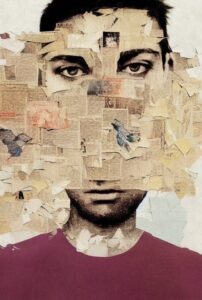
a young man collage (2022)
Alphonse Mucha

Abigail-collage-knowledge-is-her (2025)
Jordan McRae
Material Display
Basic Material Selection:
Ask yourself, “Which media do I use most often?” Select media materials that resonate with your daily life (e.g., Instagram, YouTube, newspapers, or magazines).
If you find it inconvenient to prepare, I have provided a set of popular media materials.

Tool List:
– Paper or canvas
– Printed media materials (Basic materials)
– Scissors, glue, or tape
– Markers, crayons
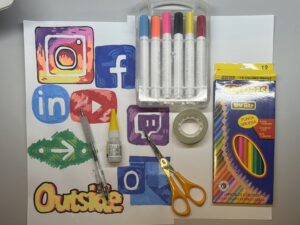
(Digital version: Use Miro or Procreate. Prepare an online media material library and online sticky note tool.)
Creation Steps: Collage Portrait (14 minutes)
Step 1: Draw the Outline of the Portrait (1 minute)
Use a marker to draw your own outline on the paper. It can be either a bust or a full-body figure.
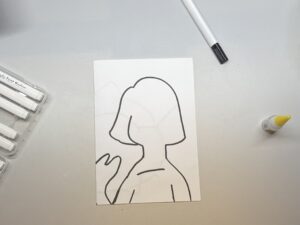
Step 2: Select Elements (3 minutes)
First, think about 2 simple questions:
- “Which media do I use most every day?”
- “What does this media help me do?”
Then, cut out the elements you are most familiar with and feel most connected to from the media materials.
For example: I use Instagram most frequently. Instagram helps me learn about outfits and entertainment news. Therefore, I can cut out the information headlines that interest me most and the clothes I like.
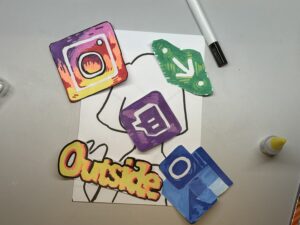
Step 3: Paste Elements (8 minutes)
First, think about 1 simple question:
“Which part of your body is related to these elements?”
Paste the selected elements on the corresponding part of the outline on the paper.
For example: Paste entertainment news headlines on the “eyes” because entertainment news will influence my views on real-world events.
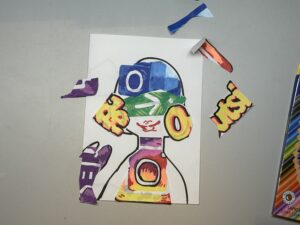
Tip: After completing the collage of elements, you can add some decorations with colored pens. It’s up to you!
Step 4: Reflect and Annotate “Connection and Essence” (2 minutes)
Use a marker to write 1-2 keywords for each material:
First question: “What does the media extend for me?”
For example, write “extended aesthetic appreciation” beside Instagram.
Second question: “What lies behind the media?”
For example, write “consumerism” beside Instagram.

Reflection and Feeling (1 minute)
Look at your collage and answer 2 self-reflection questions:
- Can I explain “media as an extension of humans” through the collage portrait?
- Do I have new views on media?
a young man collage © 2022 by Alphonse Mucha is licensed under CC BY-SA 4.0
Abigail-collage-knowledge-is-her © 2025 by Jordan McRae is licensed under CC BY-SA 4.0
Reflective Collage Portrait: Unraveling “Media as an Extension of Humans” © 2025 by Huijia Feng is licensed under Creative Commons Attribution-NonCommercial-ShareAlike 4.0 International


